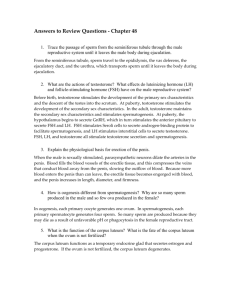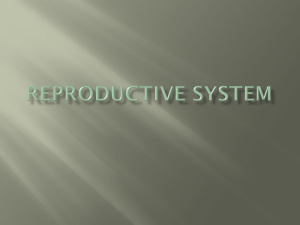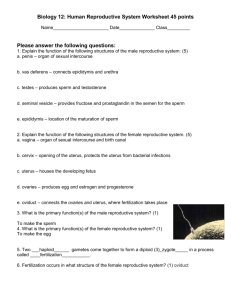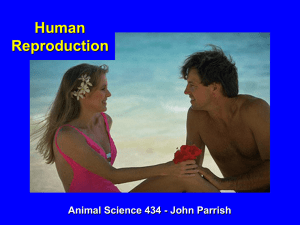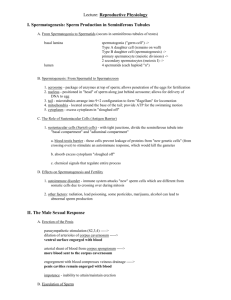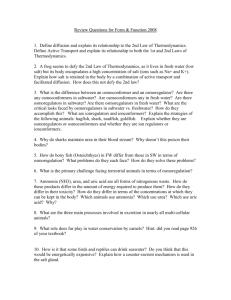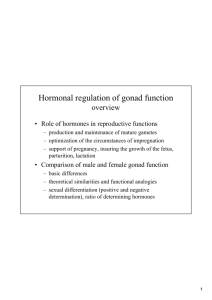S T U D Y G U I D E
advertisement
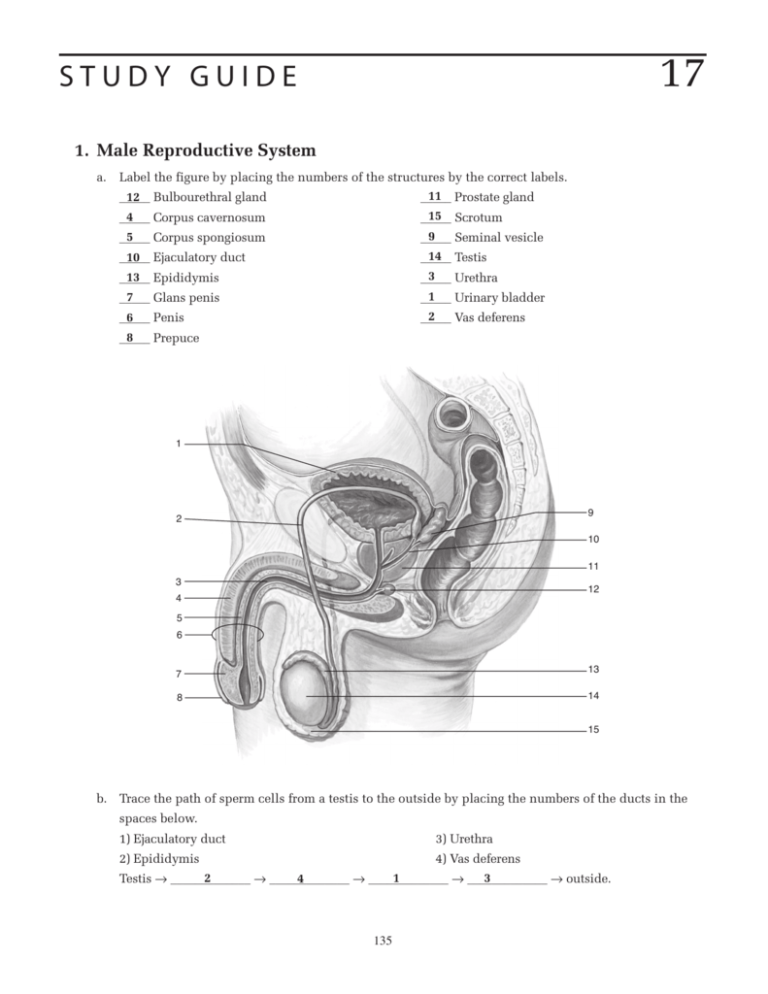
17 STUDY GUIDE 1. Male Reproductive System a. Label the figure by placing the numbers of the structures by the correct labels. 11 Prostate gland 12 Bulbourethral gland _____ _____ 15 Scrotum _____ 9 _____ Seminal vesicle 4 _____ Corpus cavernosum 5 _____ Corpus spongiosum 14 Testis _____ 3 _____ Urethra 10 Ejaculatory duct _____ 13 Epididymis _____ 1 _____ Urinary bladder 2 _____ Vas deferens 7 _____ Glans penis 6 _____ Penis 8 _____ Prepuce 1 9 2 10 11 3 12 4 5 6 7 13 8 14 15 b. Trace the path of sperm cells from a testis to the outside by placing the numbers of the ducts in the spaces below. 1) Ejaculatory duct 3) Urethra 2) Epididymis 4) Vas deferens 2 3 1 4 Testis → _____________ → _____________ → _____________ → _____________ → outside. 135 c. Write the terms that match the statements in the spaces at the right. 1) Male gonads, or sex glands. Testis ____________________________________________ 2) Tubules producing sperm cells. Seminiferous tubules ____________________________________________ 3) Cells producing testosterone. ____________________________________________ Interstitial cells 4) Process of sperm formation. ____________________________________________ Spermatogenesis 5) Number of chromosomes in spermatogonia 46 ____________________________________________ and primary spermatocytes. 6) Type of cell division forming primary ____________________________________________ Mitosis spermatocytes. 7) Type of cell division forming spermatids from primary spermatocytes. ____________________________________________ Meiosis 8) Number of chromosomes in each spermatid. ____________________________________________ 23 9) Cell formed from each spermatid. ____________________________________________ Sperm 10) Location of nucleus in a sperm cell. ____________________________________________ In the head 11) Provides motility for a sperm cell. ____________________________________________ Flagellum 12) Tubule where sperm cells mature. ____________________________________________ Epididymis 13) Secrete fluid, neutralizing acidity of urethra prior to ejaculation. ____________________________________________ Bulbourethral glands 14) Secrete fluid containing fructose. ____________________________________________ Seminal vesicles 15) Secretes fluid, activating swimming movements of sperm cells. ____________________________________________ Prostate gland 16) Mixture of glandular secretions and sperm cells. ____________________________________________ Semen 17) Contains testes outside the body. ____________________________________________ Scrotum 18) Approximate temperature of testes required for production of viable sperm. ____________________________________________ 95.6° F 19) Male copulatory organ inserted into vagina during sexual intercourse. ____________________________________________ Penis 20) Erectile tissue in penis surrounding urethra. ____________________________________________ Corpus spongiosum 21) Two dorsal columns of erectile tissue in penis. ____________________________________________ Corpora cavernosa 22) Sheath of skin covering the glans penis. ____________________________________________ Prepuce 2. Male Sexual Response Write the words that complete the sentences in the spaces at the right. Sexual stimulation causes ____1___ nerve 1) ___________________________________________ Parasympathetic impulses to ____2___ the arterioles and 2) ___________________________________________ Dilate ____3___ the venules serving the erectile tis- 3) ___________________________________________ Constrict sue in the penis. Engorgement of the erectile 4) ___________________________________________ Erection tissue results in ____4___ of the penis. At 5) ___________________________________________ Bulbourethral the same time, the ____5___ glands secrete 6) ___________________________________________ Acidity an alkaline fluid that neutralizes the 7) ___________________________________________ Orgasm ____6___ of the urethra. Continued sexual 8) ___________________________________________ Ejaculation stimulation results in ____7___ , which is characterized by a sensation of sexual pleasure and ____8___ , the forcing of ____9___ out the urethra. 136 9) ___________________________________________ Semen 3. Hormonal Control of Reproduction in Males a. Write the terms that match the statements in the spaces at the right. 1) The male sex hormone. ____________________________________________ Testosterone 2) Secretes gonadotropin-releasing hormone. ____________________________________________ Hypothalamus 3) Releases FSH and LH. ____________________________________________ Anterior pituitary 4) Hormone stimulating testosterone secretion LH (ICSH) ____________________________________________ by testes. 5) Two hormones that act together to stimulate FSH; testosterone ____________________________________________ spermatogenesis. 6) Stimulates maturation of male sex organs. Testosterone ____________________________________________ 7) Stimulates development and maintenance of ____________________________________________ Testosterone secondary sexual characteristics. ____________________________________________ Adrenal cortex 8) Produces androgens in male fetus. 9) Hormone whose first secretion triggers onset of puberty. ____________________________________________ FSH 10) Hormone stimulating release of FSH and LH. ____________________________________________ GnRH b. Record the numbers of the male secondary sexual characteristics listed in the space provided. 1) Maturation of the testes. 6) Increased metabolic rate. 2) Enlargement of the larynx. 7) Increased muscle development. 3) Broad shoulders. 8) Increased RBC production. 4) Growth of body hair. 9) Maturation of the penis. 5) Production of sperm cells. 10) Deepening of the voice. ____________________________________________ 2, 3, 4, 6, 7, 8, 10 c. Write the words that complete the sentences in the spaces at the right. The production of testosterone by ____1___ in 1) ___________________________________________ Seminiferous tubules the testes is regulated by a ____2___ feedback 2) ___________________________________________ Negative system. When the level of testosterone in the 3) ___________________________________________ GnRH blood declines, secretion of ____3___ by the 4) ___________________________________________ Increased hypothalamus is ____4___ , causing an 5) ___________________________________________ Increase ____5___ in the release of ____6___ from the 6) ___________________________________________ LH (ICSH) anterior pituitary, which, in turn, ____7___ 7) ___________________________________________ Increases testosterone production. As the level of 8) ___________________________________________ GnRH testosterone increases, it inhibits ____8___ 9) ___________________________________________ LH (ICSH) production, which decreases the release of 10) ___________________________________________ Decrease ____9___ , resulting in a ____10___ in testosterone production. 137 4. Female Reproductive System a. Label the figure by placing the numbers of the structures by the correct labels. 12 _______ Anus 8 _______ Labium major 4 _______ Urinary bladder 10 _______ Cervix 7 _______ Labium minor 1 _______ Uterine tube 6 _______ Clitoris 2 _______ Ovary 3 _______ Uterus 9 _______ Fimbriae 5 _______ Urethra 11 _______ Vagina 1 9 2 3 4 10 5 6 11 7 12 8 b. Write the terms that match the statements in the spaces at the right. 1) Produces female sex cells. ____________________________________________ Ovaries 2) Receives penis in sexual intercourse. ____________________________________________ Vagina 3) Holds embryo/fetus during pregnancy. ____________________________________________ Uterus 4) Carries secondary oocyte toward uterus. ____________________________________________ Uterine tube 5) Narrow space between labia minora. ____________________________________________ Vestibule 6) Birth canal during childbirth. ____________________________________________ Vagina 138 c. Write the words that complete the sentences in the spaces at the right. During fetal development, ____1___ cell divi- 1) ___________________________________________ Mitotic sion of germinal epithelial cells forms millions 2) ___________________________________________ Oogonia of ____2___ , but most of them degenerate. Sur- 3) ___________________________________________ Primary vivors become ____3___ oocytes containing 4) ___________________________________________ 46 ____4___ chromosomes. Single layers of follicu- 5) ___________________________________________ Primordial lar cells envelop each oocyte forming ____5___ 6) ___________________________________________ Primary follicles, but most of them degenerate; the sur- 7) ___________________________________________ One vivors become ____6___ follicles. After puberty, 8) ___________________________________________ Meiotic usually ____7___ dominant follicle develops 9) ___________________________________________ Secondary each month, and its oocyte undergoes the first 10) ___________________________________________ Polar body ____8___ division, producing a ____9___ oocyte 11) ___________________________________________ 23 and a first ____10___ . Both of these cells con- 12) ___________________________________________ Ovulation tain ____11___ chromosomes. Continued 13) ___________________________________________ Uterine tube growth results in rupture of the follicle at 14) ___________________________________________ Sperm ____12___ , and the released oocyte enters a 15) ___________________________________________ Meiotic ____13___ tube. If the secondary oocyte is pene- 16) ___________________________________________ Ovum trated by a ____14___ , the second ____15___ di- 17) ___________________________________________ Polar body vision forms an ____16___ and a second 18) ___________________________________________ 23 ____17___ , each with ____18____ chromosomes. d. Write the terms that match the statements in the spaces at the right. 1) Inner lining of the uterus. ____________________________________________ Endometrium 2) Moves an oocyte through a uterine tube. Cilia ____________________________________________ 3) Type of muscle in uterine wall. ____________________________________________ Smooth 4) Collective term for the external female reproductive organs. ____________________________________________ Vulva 5) Nodule of erectile tissue corresponding to the penis in males. ____________________________________________ Clitoris 6) Portion of uterus projecting into vagina. e. ____________________________________________ Cervix Female Sexual Response Write the words that complete the sentences in the spaces at the right. Sexual stimulation results in enlargement of the __1__ and erection of the __2__ and nip- Vaginal mucosa and breasts 1) ___________________________________________ ples due to increased blood flow. Increased Clitoris 2) ___________________________________________ secretion of the __3__ glands lubricates the Vestibular 3) ___________________________________________ vestibule. Sexual response culminates in Orgasm 4) ___________________________________________ __4__, which produces rhythmic contractions Uterus 5) ___________________________________________ of the pelvic floor, __5__, and __6__ tubes Uterine 6) ___________________________________________ plus intense pleasure. 139 5. Hormonal Control of Reproduction in Females a. Match the hormones listed with the following statements. Estrogen GnRH Progesterone FSH LH 1) Secreted by the follicular cells. ____________________________________________ Estrogen, progesterone 2) Stimulates maturation of female sex organs. ____________________________________________ Estrogen ____________________________________________ 3) Maintains uterine lining in pregnancy. Progesterone 4) Develops female secondary sexual characteristics. ____________________________________________ Estrogen ____________________________________________ 5) Secreted by corpus luteum. Estrogen, progesterone ____________________________________________ 6) Secreted by the hypothalamus. GnRH 7) Stimulates development and function of corpus 8) 9) 10) 11) 12) 13) luteum. First secretion starts onset of puberty. Stimulates development of ovarian follicles. Prepare endometrium for pregnancy. High concentrations inhibit GnRH secretion. Promotes thickening of endometrium. Promotes formation of blood vessels in endometrium. ____________________________________________ LH ____________________________________________ GnRH and FSH ____________________________________________ FSH ____________________________________________ Progesterone ____________________________________________ Progesterone ____________________________________________ Estrogen ____________________________________________ Progesterone b. Write the words that complete the sentences in the spaces at the right. Between puberty and ____1___ , a woman experi1) ___________________________________________ Menopause ences one reproductive cycle per month consisting 2) ___________________________________________ Menstrual of an ovarian cycle and a ____2___ cycle. These cy3) ___________________________________________ Hormones cles are controlled by ____3___ and average about 4) ___________________________________________ 28 ____4___ days in length. A cycle is started by the 5) ___________________________________________ GnRH secretion of ____5___ by the hypothalamus, which 6) ___________________________________________ FSH activates the release of ____6___ and ____7___ by 7) ___________________________________________ LH the anterior pituitary. FSH stimulates the develop8) ___________________________________________ Follicle ment of a primary ____8___ and the secretion of Estrogen ____9___ by the follicular cells. ____10___ promotes 9) ___________________________________________ Estrogen the thickening of the endometrium. The increasing 10) ___________________________________________ 11) ___________________________________________ LH estrogen production triggers a sharp increase in ____11___ secretion and a lesser increase in FSH production, leading to ____12___ on day 14. Under stimulation by LH, the follicle remnants become a ____13___ that secretes a high level of ____14___ and estrogen, which together prepare the ____15____ of the uterus to receive an early embryo. The high level of ____16___ inhibits secretion of GnRH, preventing development of additional ovarian follicles. If pregnancy does not occur, the corpus luteum degenerates and the levels of estrogen and ____17____ rapidly decline, resulting in breakdown of the endometrium leading to ____18___ and secretion of GnRH starting a new reproductive cycle. 140 12) ___________________________________________ Ovulation 13) ___________________________________________ Corpus luteum 14) ___________________________________________ Progesterone 15) ___________________________________________ Endometrium 16) ___________________________________________ Progesterone 17) ___________________________________________ Progesterone 18) ___________________________________________ Menstruation 6. Mammary Glands Indicate whether each statement is true (T) or false (F). T _______ Mammary glands are specialized for milk production. F _______ Breasts contain connective tissue but little fat. T _______ Alveolar glands occur in lobes of mammary glands. T _______ Estrogen stimulates the development of mammary glands. T _______ A pigmented areola surrounds a protruding nipple. T _______ Mammary glands are present, but nonfunctional, in males. F _______ Breasts are formed internal to the pectoralis muscles. 7. Birth Control Indicate whether each statement is true (T) or false (F). T _______ Contraceptives are designed to prevent union of sperm and egg. F _______ Contraceptives and birth control are synonymous. T _______ Spermicides act by killing the sperm cells. T _______ Progesterone in the “pill” inhibits GnRH secretion. T _______ Spermicides are usually used with barrier methods. F _______ It is impossible to catch STDs when using a condom. T _______ Diaphragms and cervical caps are about equally effective. T _______ The rhythm method relies on knowing when ovulation occurs. T _______ A condom is a barrier contraceptive. F _______ Pregnancy is not possible when using a condom. F _______ The “pill” is the most effective contraceptive. F _______ There are no undesirable side effects of the “pill.” T _______ An IUD prevents implantation of an embryo. F _______ Induced abortion is a contraceptive procedure. F _______ A tubal ligation prevents ovulation. T _______ Diaphragms and cervical caps are barrier contraceptives. T _______ A vasectomy prevents the ejaculation of sperm. T _______ Use of an IUD may cause pelvic inflammatory disease. T _______ Withdrawal is less effective than a condom. T _______ Undesirable side effects may result from induced abortion. 8. Disorders of the Reproductive Systems Write the disorders that match the statements in the spaces provided. Male Disorders 1) Inability to maintain an erection. ____________________________________________ Impotence 2) Common reproductive cancer in males. ____________________________________________ Prostate 3) Inflammation of the prostate glands. ____________________________________________ Prostatitis 4) Inability to produce sufficient viable sperm. ____________________________________________ Infertility 5) Causes constriction of urethra in about one-third of older males. ____________________________________________ Enlarged prostate 141 Female Disorders 1) Physical pain during menstruation. ____________________________________________ Dysmenorrhea 2) Growth of endometrial tissue outside the uterus. ____________________________________________ Endometriosis 3) Absence of menstruation without pregnancy. ____________________________________________ Amenorrhea 4) Associated with highly absorbent tampons. ____________________________________________ Toxic shock syndrome 5) Inability to become pregnant. ____________________________________________ Infertility 6) Infection in reproductive organs and/or pelvic ____________________________________________ Pelvic inflammatory disease cavity. 7) Physical and emotional distress just prior to menstruation. ____________________________________________ Premenstrual syndrome 8) Caused by toxin formed by S. aureus. ____________________________________________ Toxic shock syndrome Sexually Transmitted Diseases 1) Results from infection with herpes simplex virus type 2. ____________________________________________ Genital herpes 2) Fatal disease resulting from HIV infection. ____________________________________________ AIDS 3) Two bacterial diseases that may lead to sterility in females. ____________________________________________ Gonorrhea ____________________________________________ Chlamydia 4) Characterized by chancre in first stage. ____________________________________________ Syphilis 5) Caused by human papillomavirus (HPV). ____________________________________________ Genital warts 6) Bacterial diseases curable with antibiotics. ____________________________________________ Syphilis ____________________________________________ Gonorrhea ____________________________________________ Chlamydia 7) Viral diseases for which there are no cures. ____________________________________________ AIDS ____________________________________________ Genital herpes ____________________________________________ Genital warts 9. Clinical Applications a. Failure of the testes to descend into the scrotum (cryptochordism) causes sterility in males. Explain why. ________________________________________________________________________________ Normal body temperature prevents the development of viable sperm. A lower _____________________________________________________________________________________________ temperature, about 95.6°F., is required for production of viable sperm. b. Secondary amenorrhea in female athletes results from strenuous activity, which blocks the hypothalmic regulation of reproduction. How does this stop the reproductive cycles? ___________________ When the _____________________________________________________________________________________________ production of GnRH by the hypothalamus is curtailed, ovarian and menstrual cycles cease. _____________________________________________________________________________________________ Women with amenorrhea produce little, if any, estrogen, which causes osteoporosis (bone loss). Why are such women deficient in estrogen? _________________________________________________________ When GnRH is not produced by the hypothalamus, FSH is not se_____________________________________________________________________________________________ creted by the anterior pituitary. Without stimulation by FSH, follicular cells do not secrete estrogen. c. Without effective treatment, a bacterial sexually transmitted disease usually leads to pelvic inflammatory disease (PID) in females. How does this happen? ____________________________________________ Bacteria migrate up the uterine tubes and infect _____________________________________________________________________________________________ pelvic tissues. 142

